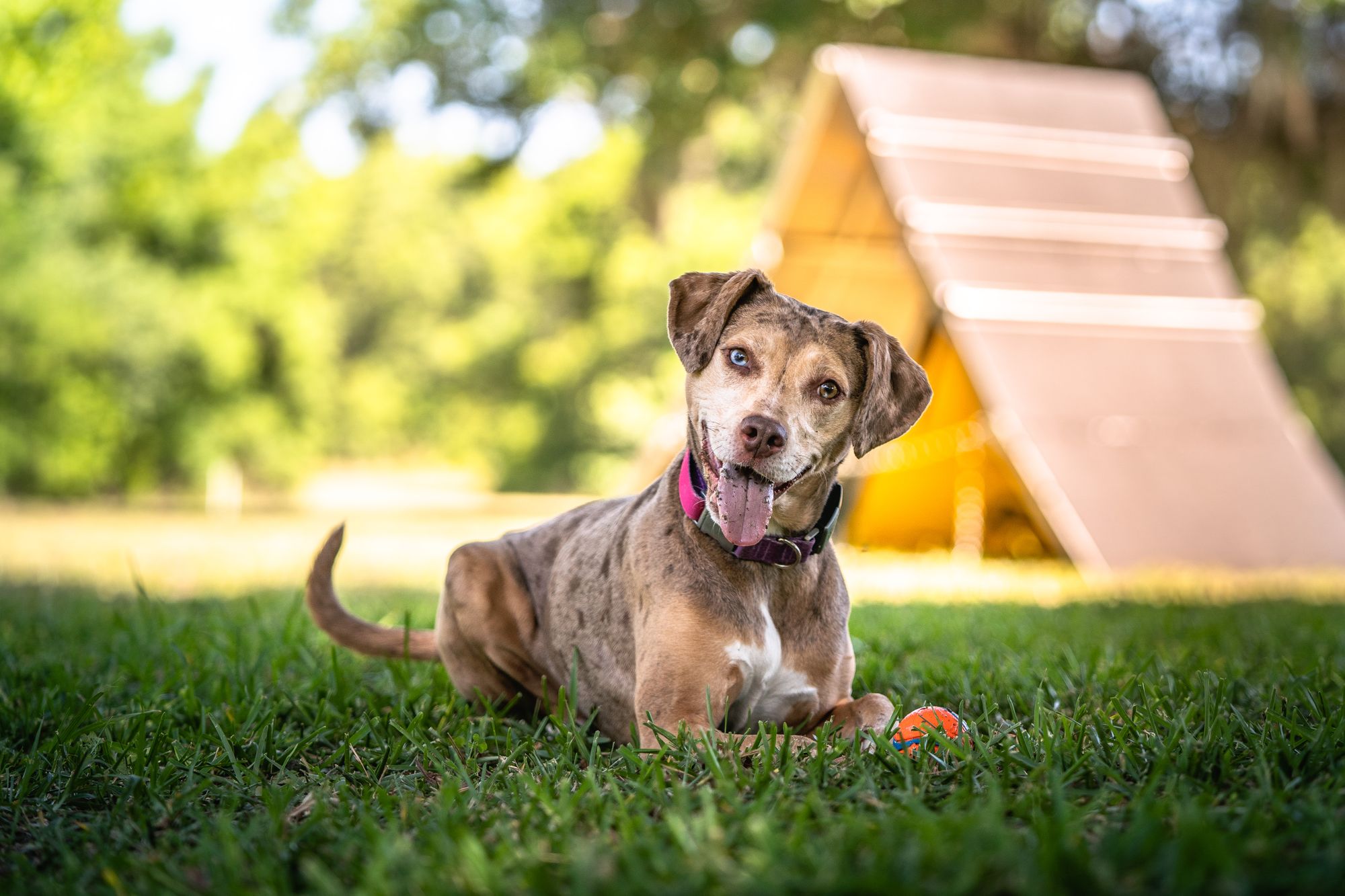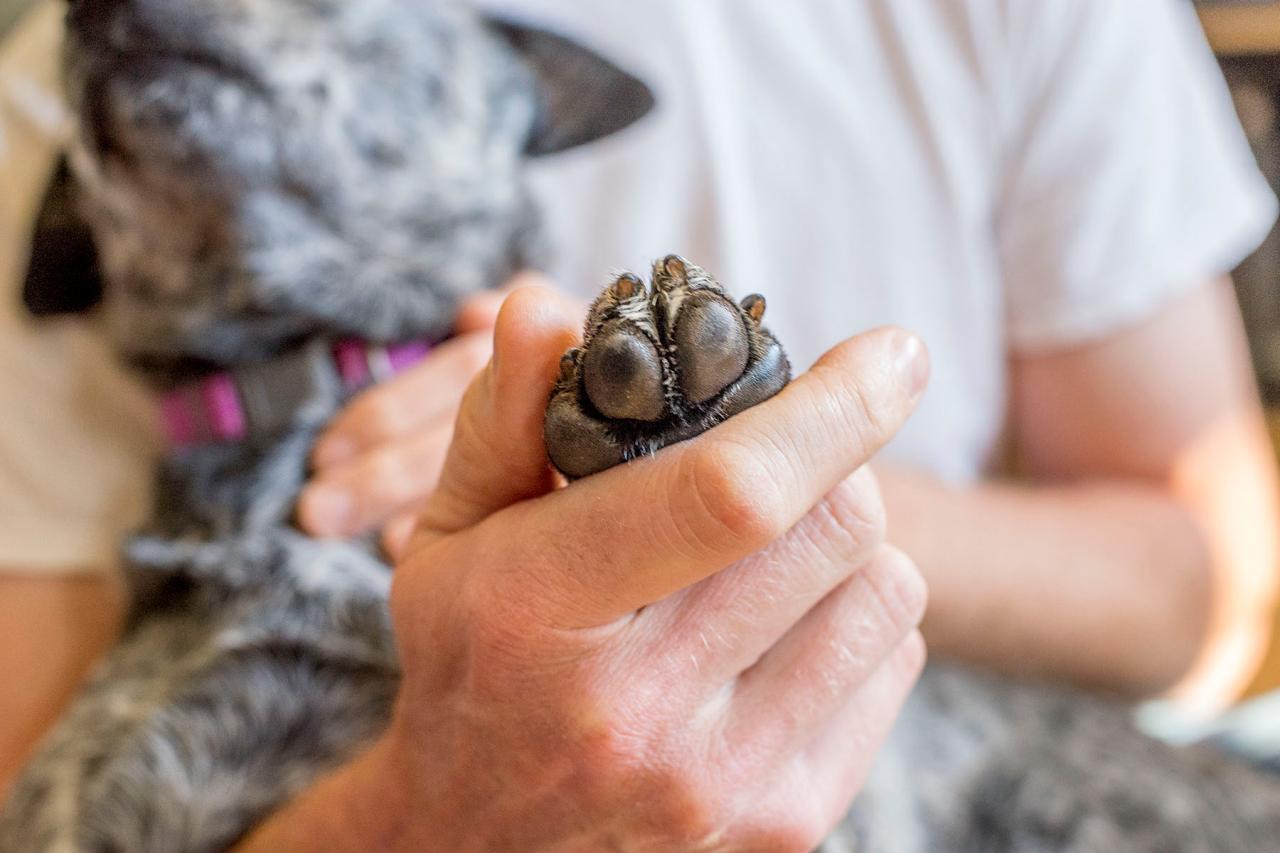We love spending time with our dogs! Naturally, as the weather gets nicer, we want our dogs to join us on as many outdoor adventures as possible. While I always encourage owners to take their dogs out to see the world, I also strongly encourage owners to learn about ways to protect their dogs while out and about. Warmer weather comes with the risk of overheating for both humans and dogs alike. Since our dogs can’t tell us outright that they feel too hot, it is important to learn about risk factors and signs of heat-induced illness as well as ways to prevent it!

So, what is heat-induced illness?
Heat-induced illness occurs when the dog’s core body temperature becomes too high and their natural thermoregulatory mechanisms can’t keep up with the rising temperature. Commonly, the term “heat stroke” comes to mind, but heat-induced illness actually encompasses a spectrum ranging from mild to severe consequences with heat stroke being the most severe and life-threatening.
Most commonly, dogs overheat due to excessive external temperature, high humidity, vigorous exercise, or a combination of these factors, though it is important to remember that heat-induced illness requires elevated core body temperature, so just because your dog exercised in hot weather does not automatically mean they will have heat-induced illness.
TIP: Hot weather can also cause other injury to your dog such as burnt paw pads and sun burns, so keeping these risks in mind is also important!
Dogs have multiple thermoregulatory mechanisms (ways their body keeps its temperature in the normal range). The most effective mechanism is evaporative cooling. In humans, evaporative cooling occurs when we sweat through our skin and the sweat evaporates.
Unlike humans, dogs do not sweat from their skin. Dogs perform evaporative cooling by panting: the moisture from their mouth, tongue, and lung lining evaporates as air is pushed over them! They also have merocrine glands, similar to sweat-glands in humans, in their paw pads, but minimal cooling comes from the paw pads due to the small surface area.
Another mechanism for cooling is vasodilation, where the blood vessels of the body dilate (expand in diameter) to allow more of the overheated blood to reach the surface of the body, including the tongue, where it can cool more effectively due to increased surface area. For this reason, you may notice your dog’s tongue, gums, ears, and skin become brighter pink or even red when they are hot. These thermoregulatory mechanisms help dogs keep their body temperature in a healthy range, but a variety of risk factors can cause them to overheat despite these mechanisms.

As we talked about before, factors like high environmental temperature, high humidity, and vigorous exercise are common reasons a dog may not be able to maintain a healthy core body temperature. Some other important factors that increase a dog’s risk of overheating include:
- Thick fur: while a dog’s coat can help insulate them from excessive heat and cold, it is important to recognize that a heavy fur coat can also make it harder for them to get rid of heat through vasodilation.
- Obesity: dogs that are overweight have more fat deposits that insulate their body and prevent them from dissipating heat as effectively. The relation of surface area to body weight plays a role in heat tolerance, so dogs that are overweight have decreased surface area in relation to body weight and thus decreased surface area with which to effectively dissipate heat. They may also have more difficulty breathing due to the fat affecting their ability to pant effectively.
- Age: Old age may decrease how quickly and effectively a dog’s body responds to changes in temperature.
- Sudden change in environment: dogs need time to acclimate to different temperatures, just like humans! You may notice that after a cold winter, 60° F weather feels very warm and pleasant, but at the end of a hot summer, 60° F weather feels cool and you may even wear a sweatshirt. This is due to your body’s ability to acclimate to different temperatures, which dogs can do, too!
- Brachycephalic breeds: while squishy-faced dogs are very cute, their unique looks also contribute to many health problems and increase their risk of heat-induced illness. Brachycephalic breeds such as pugs, bulldogs, French bulldogs, boxers, shih tzus, etc. have much shorter noses that decrease the surface area of nasal and oral mucosa that can participate in evaporative cooling. They also often have Brachycephalic Airway Syndrome, which includes an elongated soft palate, stenotic nares (narrow nose holes), everted laryngeal saccules, and laryngeal collapse. These factors increase airway resistance, making it more difficult for them to breathe compared to other dogs with longer snouts. Increased airway resistance can cause inflammation of the airway, so as brachycephalic dogs pant more heavily due to heat or exercise, they are also at risk for upper airway obstruction and respiratory distress which can be life-threatening.
How can we tell if our dogs are getting too hot?
There are some behavioral and physical signs to look for that can help clue you into how your dog is feeling. Most dogs will exhibit cool-seeking behavior, going to shady spots or laying on cool surfaces, during exercise. If you are playing lots of fetch in warm weather, keep an eye where your dog goes to take breaks. Some dogs will continue to exercise despite being too hot or tired, so it’s important to know your dog and advocate for them. Your dog may also lay down more frequently to take breaks or be lethargic (acting tired).
Physically, dogs with increased core body temperature will have heavy, fast panting (evaporative cooling), bright red gums (vasodilation), and may have vomiting, diarrhea, incoordination, and changes in mentation that can vary from depression to being comatose. If you notice these physical signs and are concerned for heat-induced illness, I recommend seeking emergency veterinary care just in case.

Many owners will recognize that their dog is hot, so there are a few things you can do to help your dog beat the heat:
- Take frequent breaks when exercising your dog, especially if the temperature outside is upwards of 80° F.
- Don’t forget to always provide fresh water for your pup so they can stay hydrated. If you are concerned that your dog is overheating, I recommend cooling from the core with lukewarm water. You can use lukewarm water to wet around your dog’s neck, body, and groin areas.
- Do not leave a wet towel draped over your dog anywhere as it can actually trap heat against their body. A common instinct is to hose your dog down, which is actually an extremely effective way of providing evaporative cooling, but if your dog’s temperature is too high and you hose them down with very cold water, you can cause vasoconstriction, opposite of vasodilation, which can push blood that is too warm back into the core, further increasing their core temperature.
- Keep your dog at a healthy, lean body weight to help them naturally be more heat tolerant. A lean dog will have easily felt ribs with minimal fat covering, a defined hour-glass waist when looking down from above, and you should be able to see the last few ribs in short-haired dogs. Your vet can help you hone in on a diet plan that suits your pup.
My final recommendation is to leave your pup at home on days when it is simply too hot outside. As loving dog owners, the temptation is to take our dogs everywhere with us, but sometimes the best thing you can do is leave them home with the air-conditioning running and find other ways to stimulate them such as training sessions and food puzzles.
When in doubt, please seek emergency medical care. Dogs with heat-induced illness that present to the emergency clinic sometimes have normal core body temperatures because of actions owners took at home prior to coming to the hospital, but there is potential for lasting effects of high core body temperature, even if their temperature returns to normal, so an emergency vet may recommend running bloodwork to monitor various organ systems and providing supportive care in the hospital. If your dog experiences heat stroke, the most severe form of heat-induced illness, they will have severe central nervous system signs – examples include weakness, incoordination, changes in mental state, muscle tremors, and even seizures – and often multi-organ dysfunction. The prognosis of heat-induced illness depends on the degree and duration of overheating, so erring on the side of caution and taking quick action is always recommended!
Safe adventuring,
Dr. Lil, VMD
Trek Dog, LLC






